This article needs additional citations for verification .(November 2015) |
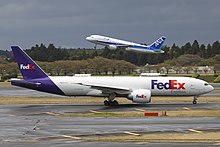


Air cargo is any property carried or to be carried in an aircraft. Air cargo comprises air freight, air express and airmail. [2]
This article needs additional citations for verification .(November 2015) |



Air cargo is any property carried or to be carried in an aircraft. Air cargo comprises air freight, air express and airmail. [2]
Different cargo can be transported by passenger, cargo or combi aircraft:

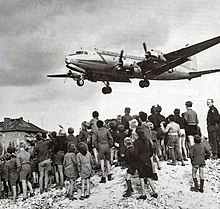
The first cargo flight took place on the 7 November 1910 in the U.S. between Dayton and Columbus in Ohio. Philip Orin Parmelee piloted a Wright Model B aeroplane 65 miles (105 km) carrying a package of 200 pounds of silk for the opening of a store. Newspaper clippings quoted the Wright brothers as stating he covered the distance in 66 minutes, but the flight was officially recorded at 57 minutes, a world speed record at the time. It was the first "cargo only" flight solely for the transport of goods; the first flight commissioned by a client, and the first example of multimodal air transport, since the pieces of silk were transported by car from Columbus aerodrome to the store.
The world's first official airmail flight by airplane took place on 18 February 1911, at a large exhibition in the United Provinces of Agra and Oudh, British India. The organizer of the aviation display, Walter Windham, was able to secure permission from the postmaster general in India to operate an airmail service in order to generate publicity for the exhibition and to raise money for charity. This first airmail flight was piloted by Henri Pequet, who flew 6,500 letters a distance of 13 km (8.1 mi), from Allahabad to Naini—the nearest station on the Bombay-Calcutta line to the exhibition. The aircraft used was a Humber-Sommer biplane with about fifty horsepower (37 kW), and it made the journey in thirteen minutes.
The world's first scheduled airmail post service took place in the United Kingdom between the London suburb of Hendon, and the Postmaster General's office in Windsor, Berkshire, on September 9, 1911. It was part of the celebrations for King George V's coronation and at the suggestion of Windham, who based his proposal on the successful experiment he had overseen in India. The service ran for just under a month, transporting 35 bags of mail in 16 flights.
In the early 1920s, air cargo developed rapidly because numerous entrepreneurs realized aircraft could move high value and low volume consignments much faster than the railroads and shipping companies. The first scheduled flight from London to Paris in 1919 had only one passenger, but carried leather for a shoe manufacturer and grouse for a restaurant. Cinema films were also a frequent consignment: original news’ bulletins were first carried to a central laboratory to make copies, and then distributed by air throughout Europe for their release in cinemas.
Although there were a few attempts to organize air freight airlines from the 1920s on, the first commercial airlines that were all-cargo did not emerge until after World War II.
In 1945, at a conference in Havana, 57 airlines formed the International Air Transport Association.
In 1948, Berlin was jointly controlled by the Western Allies and Soviet Union, although the Soviet Union held the area surrounding the city and thus land access. During the Berlin Blockade, this land access was closed, and an airlift remained the only option to get increasingly urgent deliveries of food, coal, and other supplies to West Berlin. Over 330 days to 12 May 1949 a total of 2.26 million tons of cargo were airlifted to Berlin, an average of 6,800 tons a day, 80% by the US and 20% by the UK. [3]
Although freight traffic developed modestly, reaching only 800,000 tonnes worldwide by the mid-1950s, the world economy was hitting its post-World War II stride. Germany and Japan were emerging from their period of purgatory and were poised to take the world of business by storm, the United States was approaching the height of its economic dominance, and Western Europe had recovered from the war. In 1968, Boeing launched the four engine 747, the first wide-body aircraft. The 747 was the first aircraft capable of transporting full pallets in the cargo hold, revolutionizing the air cargo industry.
Despite widespread hopes for a vibrant industry, for decades the air freight sector did not grow as expected and remained a very small part of total air traffic. For much of the first five post-war decades, most carriers saw it as a secondary activity, although there had always been specialized cargo airlines. Some passenger airlines have found the practice of carrying belly cargo to be a highly lucrative enterprise; in fact, it is estimated that 50% of all air freight is moved in this way, to the point where it has lessened the demand for dedicated large cargo aircraft. [4] [5]
Cargo emerged as a solid pillar of the industry in the 1990s. The catalysts for the renewed growth in the sector were the express parcel carriers, typified by FedEx, DHL, PostNL, and UPS, and changes in practices in the manufacturing sector. In 1992, FedEx sent software on computer disks to thousands of customers, allowing them to track shipments from their own workstations.
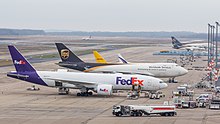
The rise of internet in the years that followed contributed to increase the reliability and accessibility to the air cargo industry. Most airlines now offer to their customers real-time flight status and the booking and tracking options. In addition, the industry is adopting electronic procedures, [6] such as the electronic air waybill, to reduce the amount of paper documentation accompanying each shipment and increasing the security and safety of the transportation. Many retailers are making an effort to integrate the air cargo delivery process with their customer service offering to respond to increasing consumer pressure. [7]
An industry expert estimates that 15-20 tonnes of air cargo is worth 30-40 economy passenger seats, when both are on passenger planes. [8]
However, with the exception of the integrators (FedEx, UPS, DHL and TNT) the air cargo industry continues to suffer as the by-product 'poor-relation' of the passenger business.[ citation needed ]
In 2017, the IATA observed a 9% rise in freight tonne kilometers: air cargo demand is strong due to industrial production and global trade growth above expansion of e-commerce, outpacing capacity as available tonne kilometers grew by 3%. Boeing doubled its 767F production since 2016 to three per month in 2020, [9] and anticipates that total global air cargo traffic will more than double by 2041. [10]

The Boeing 747 is a large, long-range wide-body airliner designed and manufactured by Boeing Commercial Airplanes in the United States between 1968 and 2023. After introducing the 707 in October 1958, Pan Am wanted a jet 2+1⁄2 times its size, to reduce its seat cost by 30%. In 1965, Joe Sutter left the 737 development program to design the 747. In April 1966, Pan Am ordered 25 Boeing 747-100 aircraft, and in late 1966, Pratt & Whitney agreed to develop the JT9D engine, a high-bypass turbofan. On September 30, 1968, the first 747 was rolled out of the custom-built Everett Plant, the world's largest building by volume. The first flight took place on February 9, 1969, and the 747 was certified in December of that year. It entered service with Pan Am on January 22, 1970. The 747 was the first airplane called a "Jumbo Jet" as the first wide-body airliner.
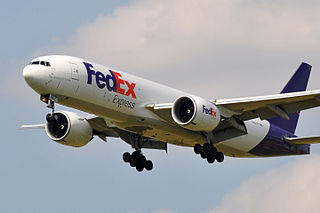
Cargo airlines are airlines mainly dedicated to the transport of cargo by air. Some cargo airlines are divisions or subsidiaries of larger passenger airlines. In 2018, airline cargo traffic represented 262,333 million tonne-kilometres with a 49.3% load factor: 52.1% for dedicated cargo operations, and 47.9% within mixed operations.

The Boeing 757 is an American narrow-body airliner designed and built by Boeing Commercial Airplanes. The then-named 7N7, a twinjet successor for the trijet 727, received its first orders in August 1978. The prototype completed its maiden flight on February 19, 1982, and it was FAA certified on December 21, 1982. Eastern Air Lines placed the initial 757-200 variant in commercial service on January 1, 1983. A package freighter (PF) variant entered service in September 1987 and a combi model in September 1988. The stretched 757-300 was launched in September 1996 and began service in March 1999. After 1,050 had been built for 54 customers, production ended in October 2004, while Boeing offered the largest 737 NG variants as a successor.

Air North Charter and Training Ltd., operating as Air North, Yukon's Airline, is a Canadian airline based in Whitehorse, Yukon. It operates scheduled passenger and cargo flights throughout Yukon, as well as between Yukon and the Northwest Territories, British Columbia, Alberta, and Ontario. The airline also operates charter flights throughout Canada and Alaska. The airline also provides ground handling services and fuel services to other airlines throughout Yukon, and it also provides ground handling services at Vancouver International Airport and Edmonton International Airport. Its main base is Erik Nielsen Whitehorse International Airport.

The Boeing C-40 Clipper is a military version of the Boeing 737 Next Generation used to transport cargo and passengers. It is used by the United States Navy, Air Force, and Marine Corps. The Navy C-40A variant is named "Clipper", whereas the USAF C-40B/C variants are officially unnamed.
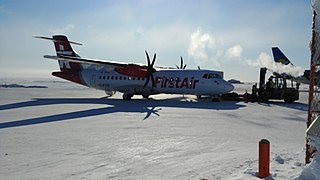
Bradley Air Services Limited, operating as First Air, was an airline headquartered in Kanata, a suburb of Ottawa, Ontario, Canada. It operated services to 34 communities in Nunavut, Nunavik, and the Northwest Territories. First Air has assisted in various humanitarian missions such as the 2010 Haiti earthquake, airlifting relief supplies and equipment. Its main base, which included a large hangar, cargo and maintenance facility, was located at Ottawa Macdonald–Cartier International Airport, with hubs at Iqaluit Airport, and Yellowknife Airport. On November 1, 2019, the airline consolidated operations with Canadian North.
EVA Airways Corporation, of which "EVA" stands for Evergreen Airways, is one of the two largest airlines in Taiwan – the other being China Airlines. It operates passenger and dedicated cargo services to over 40 international destinations in Asia, Australia, Europe, and North America. In contrast to the state-owned flag carrier China Airlines, EVA Air is privately owned and flies a fully international route network with no domestic destinations. It is rated as a 5-star airline by Skytrax, and is the second largest airline based in Taiwan after China Airlines. EVA Air is headquartered at Taoyuan International Airport in Luzhu, Taoyuan City. The company slogan is "Sharing the World, Flying Together".
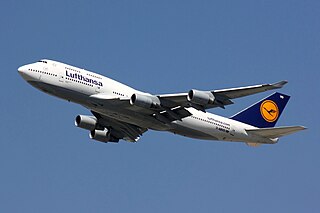
The Boeing 747-400 is a large, long-range wide-body airliner produced by Boeing Commercial Airplanes, an advanced variant of the initial Boeing 747. The "Advanced Series 300" was announced at the September 1984 Farnborough Airshow, targeting a 10% cost reduction with more efficient engines and 1,000 nautical miles [nmi] of additional range. Northwest Airlines became the first customer with an order for 10 aircraft on October 22, 1985. The first 747-400 was rolled out on January 26, 1988, and made its maiden flight on April 29, 1988. Type certification was received on January 9, 1989, and it entered service with NWA on February 9, 1989.
AHK Air Hong Kong Limited is an all-cargo airline based in Chek Lap Kok, Hong Kong, with its main hub at Hong Kong International Airport. The airline operates an express freight network to 13 destinations in nine countries, including China, Japan, Malaysia, Philippines, Taiwan, Singapore, South Korea, Thailand and Vietnam. It has a fleet of Airbus A300-600F General Freighters, which the airline was the launch customer of this new variant. Its head office is located on the fourth floor of the South Tower of Cathay Pacific City.
ABX Air, Inc., formerly Airborne Express, is a cargo airline headquartered at Wilmington Air Park near the City of Wilmington, Ohio, USA. ABX Air operates scheduled, ad hoc charter and ACMI freight services. It also provides flight support services and training. ABX Air is owned by Air Transport Services Group.
Singapore Airlines Cargo is the unit within Singapore Airlines (SIA) responsible for air cargo operations. It was incorporated in 1988. SIA Cargo manages the cargo operations of SIA's fleet of freight- and passenger aircraft. Its main office is on the fifth floor of the SATS Airfreight Terminal 5 at Singapore Changi Airport.
The largest airlines in the world can be defined in several ways. As of 2023, Delta Air Lines is the largest by revenue, assets value, fleet size, and market capitalization; American Airlines Group by passengers carried, revenue passenger mile, number of employees and destinations served; FedEx Express by freight tonne-kilometers; Ryanair by number of routes; and Turkish Airlines by number of countries served.
Emirates SkyCargo is a cargo airline based in Dubai, United Arab Emirates. As of 2020, it is the fourth largest cargo airline worldwide in terms of the total freight tonne-kilometres flown and international freight tonne-kilometres flown.

Combi aircraft in commercial aviation are aircraft that can be used to carry either passengers as an airliner, or cargo as a freighter, and may have a partition in the aircraft cabin to allow both uses at the same time in a mixed passenger/freight combination. The name combi comes from the word combination. The concept previously existed in railroading, as a passenger car that contained a separate compartment for mail and/or baggage.

A cargo aircraft is a fixed-wing aircraft that is designed or converted for the carriage of cargo rather than passengers. Such aircraft usually do not incorporate passenger amenities and generally feature one or more large doors for loading cargo. Freighters may be operated by civil passenger or cargo airlines, by private individuals or by the armed forces of individual countries.

Leipzig/Halle Airport is an international airport located in Schkeuditz, Saxony, Germany, and serves both Leipzig, Saxony, and Halle, Saxony-Anhalt.
Maersk Air Cargo, formerly branded as Star Air, is a Danish cargo airline and part of Danish business conglomerate Maersk. It operates a fleet of 14 Boeing 767 cargo aircraft. Several of these are on contract to United Parcel Service (UPS) and operate out of Cologne Bonn Airport, Germany & East Midlands Airport, UK.Star Air is headquartered in Dragør, Denmark, at the premises of Copenhagen Airport.
Air Transport Services Group (ATSG) is an American aviation holding company which provides air cargo transportation and related services to domestic and foreign air carriers and other companies that outsource their air cargo lift requirements. ATSG, is the world's largest lessor of converted Boeing 767 freighter aircraft through its leasing division, Cargo Aircraft Management. Through its principal subsidiaries, including three airlines with separate and distinct U.S. FAA Part 121 Air Carrier certificates, ATSG provides aircraft leasing, air cargo lift, passenger ACMI and charter services, aircraft maintenance services and airport ground services. ATSG's subsidiaries include Cargo Aircraft Management; ABX Air; Air Transport International; Omni Air International, Airborne Global Solutions; Airborne Maintenance & Engineering Services, including its subsidiary, Pemco Conversions dba Pemco World Air Services; and LGSTX Services.

The Alaska Airlines fleet consists of a mainline fleet consisting of all Boeing 737 series aircraft operated directly by Alaska Airlines and a regional fleet operated with Alaska branded Embraer 175 jets by the Alaska Air Group owned regional airline Horizon Air and contractor SkyWest Airlines.
A preighter, also known as cargo in cabin, is an aircraft originally intended to carry passengers but which is operated temporarily as a cargo aircraft by loading freight in the passenger cabin. The term is a portmanteau of "passenger" and "freighter" and is attributed to Lufthansa chief executive Carsten Spohr; it came to use as commercial airlines responded to the 2020 COVID-19 pandemic.